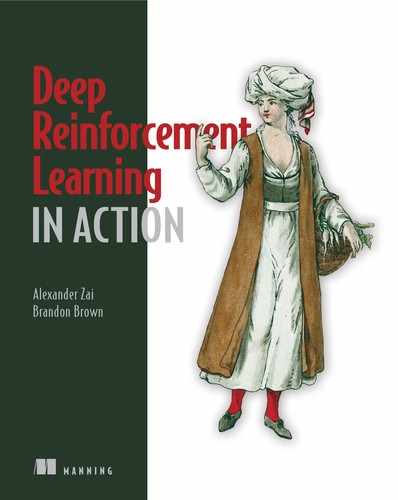0%
34Chapters
0-1Hours read
0kTotal Words
Book Description
Deep Reinforcement Learning in Action teaches you how to program AI agents that adapt and improve based on direct feedback from their environment. In this example-rich tutorial, you’ll master foundational and advanced DRL techniques by taking on interesting challenges like navigating a maze and playing video games. Along the way, you’ll work with core algorithms, including deep Q-networks and policy gradients, along with industry-standard tools like PyTorch and OpenAI Gym.Table of Contents
- Copyright
- Brief Table of Contents
- Table of Contents
- Preface
- Acknowledgments
- About This Book
- About the Authors
- About the Cover Illustration
- Part 1. Foundations
- Chapter 1. What is reinforcement learning?
- 1.1. The “deep” in deep reinforcement learning
- 1.2. Reinforcement learning
- 1.3. Dynamic programming versus Monte Carlo
- 1.4. The reinforcement learning framework
- 1.5. What can I do with reinforcement learning?
- 1.6. Why deep reinforcement learning?
- 1.7. Our didactic tool: String diagrams
- 1.8. What’s next?
- Summary
- Chapter 2. Modeling reinforcement learning problems: Markov decision processes
- Chapter 3. Predicting the best states and actions: Deep Q-networks
- Chapter 4. Learning to pick the best policy: Policy gradient methods
- Chapter 5. Tackling more complex problems with actor-critic methods
- Chapter 1. What is reinforcement learning?
- Part 2. Above and beyond
- Chapter 6. Alternative optimization methods: Evolutionary algorithms
- Chapter 7. Distributional DQN: Getting the full story
- Chapter 8. Curiosity-driven exploration
- Chapter 9. Multi-agent reinforcement learning
- Chapter 10. Interpretable reinforcement learning: Attention and relational models
- Chapter 11. In conclusion: A review and roadmap
- Appendix. Mathematics, deep learning, PyTorch
- Reference list
- Index
- List of Figures
- List of Tables
- List of Listings
